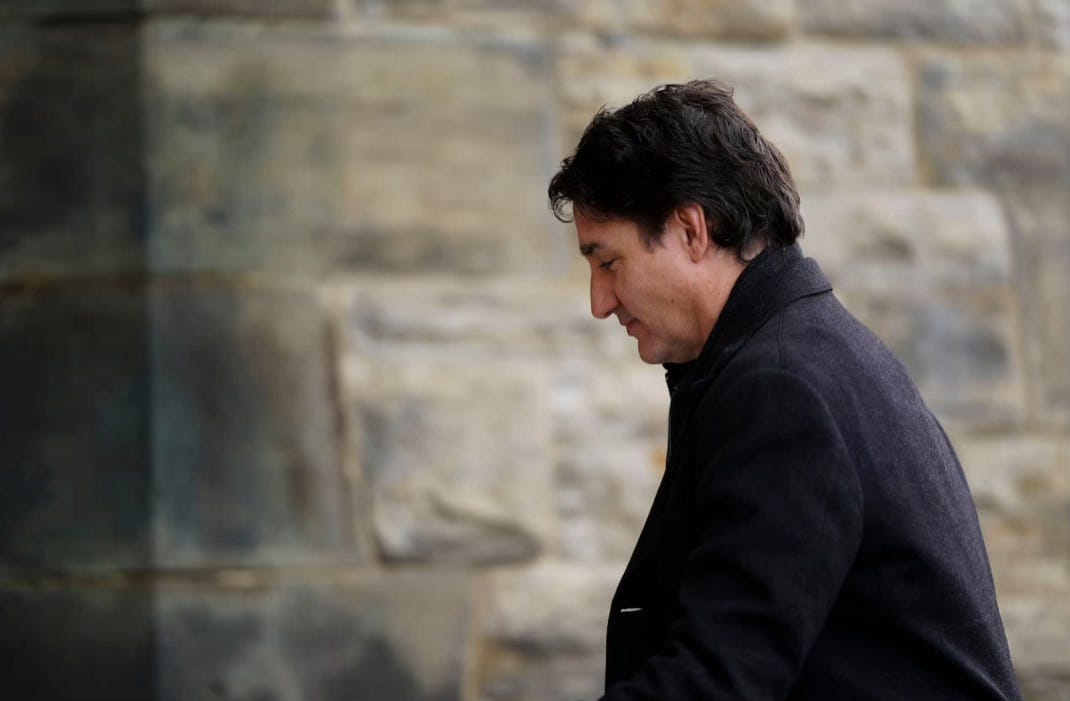A Weaker Canada
Taking Stock of Trudeau's Nine Years in Office
Sean Kilpatrick/The Canadian Pres
To prepare for the unprecedented challenges we face, more redolent of wartime than peace, Canadians need to be clear-eyed about the past decade.
Today’s media will rightly be filled with tributes to our former prime minister and speculation about the new one. Tributes are merited. Justin Trudeau is a gifted communicator. He has empathy. He genuinely loves his country.
At an Ottawa rally the day after the October 19, 2015 election, he assured those “worried that Canada has lost its compassionate and constructive voice in the world over the past 10 years” that “we’re back.”
A decade later, Canadians know that voice and empathy are not enough. We need an economy that grows and performs; effective policies backed by sound finances; tax, regulation and governance that cultivate excellence and attract investment. To prepare for the future, Canada has to compete and win today.
By the measures that count, Trudeau’s nine years and four months in office have taken us backwards. Here is a quick snapshot of an objectively weaker country:
Debt: On March 31, 2015 Canada’s federal debt (total assets less total liabilities) stood at $613.3 billion. By March 31, 2024 it was $1,236.2 trillion. By the end of the current fiscal year at the end of this month, Ottawa projects it will reach $1,441 trillion. In other words, over nine years our debt has more than doubled, while nominal GDP went from $1.986 trillion in 2015 to $3.135 trillion in 2024 – a 58% increase, which includes nine years of inflation.
Income: In 2014, Canadian enjoyed nominal per capita GDP roughly equal to that of the US. In late 2024, US per capita GDP was 50% higher.
Tax/Investment: Since 2015, Canada has squandered its advantage in corporate and capital gains taxes. The carbon tax, combined with punitive legislation that made many major pipeline and natural resource projects unviable, reduced Canada’s competitiveness (especially versus the US), as well as business investment in Canada – the latter by 7% overall and by 51% in oil and gas.
Energy: In 2015, Canada’s oil production (oil sands, conventional and offshore) was about four million barrels per day (b/d). In 2024 it was about five million barrels per day. Over the same period, US production rose by four million b/d — from 9.42 b/d in 2015 to 13.4 b/d in 2024. As Canada failed to build most pipeline and export facilities, the US went from exporting less than half a million barrels per day in 2015 to 3.8 million b/d in 2024. When nine million b/d of Russian production started to become subject to international sanctions in 2022, Canada was unable significantly to increase its exports to Europe, Asia or other markets.
Order: Over the past decade, the number of hate crimes reported to police has more than tripled from 1362 in 2015 to nearly 2,400 in only the first six months of 2024.
Defence: Canada remains the only major NATO ally without a realistic plan to spend two percent of GDP on defence, as many allies now move to three or even five percent targets. We have delayed the acquisition of new fighter jets and surface combatants. The only major budget increase was an accounting sleight of hand – to include military pensions. Morale and recruitment are abysmal; our military readiness is at a postwar low. Our military support for Ukraine per capita is among the lowest.
Security: Chinese, Russian, Iranian, Indian, Pakistani and other forms of interference in Canadian politics, diasporas and society are at all-time highs. Terrorist groups raise funds and criminal groups launder money in Canada with comparative impunity. Little has been done to curb massive campaigns of malign online influence and disinformation, fuelling hate speech and extremism.
Health: Life expectancy in Canada declined from 82 years in the period 2013-16 to 81.7 in 2023. Addiction rates have sky-rocketed, with a total of 50,928 apparent opioid toxicity deaths reported between January 2016 and September 2024. Emergency rooms are overwhelmed; millions of Canadians cannot find a family doctor.
Immigration: Backlogs are massive. Temporary immigration has ballooned. Visa fraud is out of control. International students and deserving refugees are being turned away. A long-cherished bipartisan consensus on immigration has been badly eroded.
Canada: The number of people saying they were proud to be Canadian drooped from 52% in 2016 to barely one-third in January 2025 — before the tariff bombshells hit.
In 2015 Canada was admired as a model for economic management and living standards. Today we are a struggling under-performer, under attack.
When Trump used of the phrase “America is back!” before Congress on March 4th — consciously or unconsciously echoing Trudeau’s words from 2015 — he reminded us that populism had defined the last decade, as the image and rhetoric of political leaders became increasingly detached from their track records.
Canada has been through worse. We will emerge from this new trough. With time, we will make our democracy and our alliances strong again. To get started, we need a governing team with a bold plan to restore our national finances, economic competitiveness, business investment, national defence, national security and basic competence in the administration of government.



